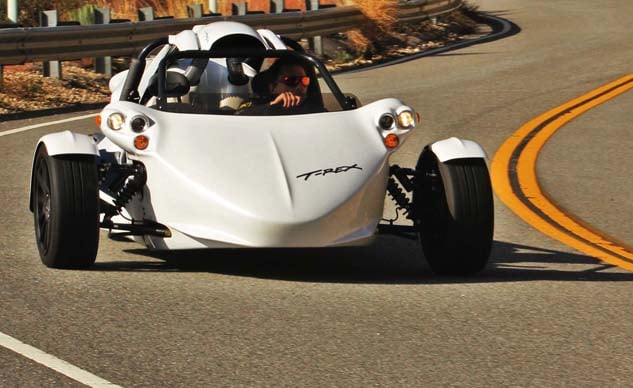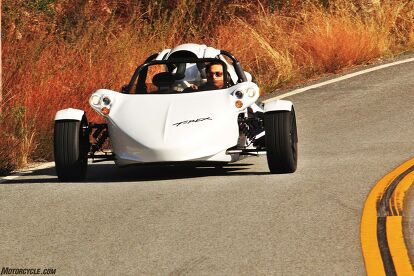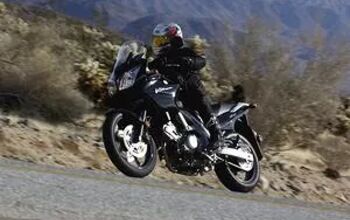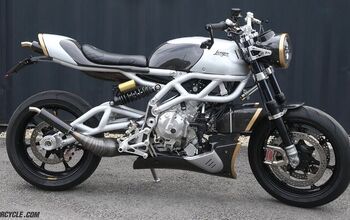Campagna T-Rex 16SP Review
An exciting moto-car half-breed powered by BMW K1600 six-cylinder
Okay, so it’s got a steering wheel and bucket seats, but it’s classified as a motorcycle in many states, and we weren’t going to turn down a chance to drive a lightweight three-wheeled car powered by a six-cylinder engine from BMW’s K1600 touring platform. That, as it turned out, was a smart choice, as the T-Rex is one of the most exhilarating motor vehicles you can aim down the road – the twistier, the better.
In fact, if anyone ever reviews one of these and doesn’t take it on a really twisty road, their findings will be worthless to anyone with a sporting bone in their body. The visually arresting T-Rex isn’t practical or cheap, but driving it is the most fun you can have on three tires while holding a steering wheel.
Of course, like all great things, there’s a price to pay for the privilege. The MSRP for the T-Rex 16S starts at $57,999, and it’s a wild-looking vehicle (autocycle is the latest descriptor and a term adopted by 40 states, says Polaris’ Slingshot crew) powered by BMW’s wonderfully whooping inline-six-cylinder motor claiming 160 hp at its crankshaft from its 1649cc. We tested the 16SP version, which adds adjustable dampers with remote reservoirs, a shorter-turn rack-and-pinion steering rack, uprated brakes and special wheels for an MSRP of $63,999. Those who saw my recent review of the latest top-line Slingshot SLR will notice it’s half the price of the T-Rex.
2018 Polaris Slingshot SLR Review
To those who decry the Slingshot’s PWC-like build quality and pedestrian powertrain, here’s the retort – and its attendant surcharge.
The other price to pay for a higher-performance three-wheeled sports car is its dedication to lightness, which mandated a tidy footprint and, hence, a tight cockpit, though not nearly as cramped laterally as the Morgan 3-Wheeler we tested a couple of years ago. But while the Morgan offers relatively easy ingress due to its roofless design (and the Slingshot even more so), the T-Rex challenges limberness by forcing a body to climb through and under a roll cage.
Polaris Slingshot Vs. Can-Am Spyder F3-S Vs. Morgan 3 Wheeler
The T-Rex was originally designed by Daniel Campagna, a friend and former mechanic for Gilles Villeneuve when the F1 driver was racing snowmobiles. Campagna’s racing roots forced a low center of gravity, resulting in the T-Rex’s stated height of just 42 inches. That’s nearly half a foot shorter than a Ferrari 458, meaning generously sized drivers might want to hit a yoga class before trying to get behind the (removable) wheel. Tall people who live in states or countries that require helmets in three-wheelers might have trouble fitting comfortably. Me, at a thin 5-foot-8, slid right in, and no helmet is needed in California.
Once inside, the driving position is as racy as a street-legal car can be. Butt cheeks are just inches off the ground, and legs are only a handful of degrees away from horizontal. Drivers of various sizes are accommodated by the trio of pedals being adjustable for reach, while the seat back has an alterable rake angle.
Punch the engine-start button, and ears are greeted by the wonderful whirring snarl of the BMW motor, and a jab on the throttle pedal results in an instant jump in revs due to negligible flywheel effect. It’s racy engine is stimulating in ways the Slingshot’s four-banger and the Morgan’s V-Twin simply can’t approach. But the motor’s absence of a flywheel combined with a narrow clutch-engagement zone makes smoothly pulling away from a stop a challenge. It can be frustratingly difficult to master until figuring out the technique of leaving the throttle alone until the clutch begins to bite, then delicately applying the gas pedal while feeding out the clutch.
Campagna’s Engine Evolution
The first production T-Rexes in 1995 were equipped with Suzuki GSX-R1100 engines, with Campagna buying complete bikes and harvesting the motors. Over the next two decades, Campagna went through several different powertrains in search of improved performance as well as steady supply. In 1999, the T-Rex switched to a Kawasaki ZX-11 engine, adding a ram-air intake to the roll cage above the seats. After Kawasaki replaced the ZX-11 with the ZX-12R in 2000, Campagna followed suit in 2002 with the bigger engine.
Excluding a limited run of 10 vehicles in 2003 that used S&S V-Twins, Campagna stuck to Kawasaki engines for several years, replacing the 1200cc engine with the ZX-14’s powerplant in 2007.
A year later, Campagna was purchased by Cirbin Motors, another Quebec company that built three-wheelers helmed by André Morissette and David Neault. The acquisition merged the two brands, with the Cirbin V13R adopting the Campagna brand and production relocating to Boucherville, Quebec. Cirbin had an engine supply agreement with Harley-Davidson for the liquid-cooled V-Rod Revolution motor, receiving whole powertrains from Milwaukee. This provided a steadier and more efficient source of engines than relying on buying whole bikes.
In 2013, Campagna signed a deal with BMW, securing a supply of six-cylinder K1600 engines that power current T-Rexes. BMW provided support by sending engineers to Quebec to help Campagna integrate electronically selectable ride modes and also supplying the K1600’s digital instrument panel. The engine supply agreement runs through 2018 with an option to renew every five years. —Dennis Chung
Once underway, the BMW powertrain is a veritable gem, erupting in a wonderfully stimulating whoop as it races toward its 8500-rpm redline. With only about 1200 pounds for 160 hp to carry around, the T-Rex is a seriously fast machine. Campagna says it can scream through the quarter-mile in 12.6 seconds, and it feels that quick from the behind the wheel. The Slingshot is a full second slower, which is the difference between merely quick and seriously quick.
The BMW Six is a sonic delight, but the gear whine and other unfiltered noises that make their way to ears is at times oppressive and makes one wish for a helmet and/or ear plugs. Gearshifts are snapped off quickly, but the tranny would be even more pleasing if it incorporated clutchless upshifts and auto-blipping downshifts as is available on the latest K1600s. Finding neutral at a stop is sometimes challenging. Wilwood four-piston calipers and braided-steel lines provide bite commensurate with the speed capabilities of the T-Rex 16SP.
The experience of driving the T-Rex on a mountain road is something quite singular and memorable. Searching for potential analogs, I’d guess this trike might feel like a lowered Lotus 7 with a three-quarter-scale old Jaguar Six motor inside. The flat-bottomed and alcantara-wrapped Sparco wheel feels secure to white-knuckled hands, delivering plentiful feedback unfiltered in a way no traditional car can. Everything is so unattenuated that it makes a Miata feel like a Bentley.
There are other sacrifices to T-Rex ownership. Protection from the elements is decidedly minimal (bring eyewear!), minimal ground clearance makes every curb and speed bump an obstacle to carefully overcome, and rain grooves on California freeways cause some front-end hunting. Quibbles include the stereo’s left-side tweeter that interferes with a driver’s leg, and the upper section of the seats don’t provide as much lateral support as the car can deliver. Oh, and it’s a fairly major sin for such a sporty car to not be equipped with a dead pedal for the driver’s left foot.
As a performance enthusiast, I’ve thus far concentrated on the details and driving impressions of the T-Rex and mostly neglected the alluring elephant in the room. Simply put, the sight of this machine will cause smartphones to draw quicker than the Rawhide Kid could unholster his six-shooter. The Slingshot also receives much attention, but it seems to be mostly of the what-the-hell-is-that… variety rather than pure admiration of the design.
The T-Rex, on the other hand, receives appreciation for more than its novelty factor. It’s a lovely piece of machinery that has flowing lines and a real sense of purpose. It can be appreciated by race-car engineers and septuagenarian ladies and everyone in between.
Naturally, there will be party poopers who will point out that autocycles like the T-Rex are encumbered by the negative aspects of both moto and auto: noise and lack of creature comforts of a bike; doesn’t lean into corners and can’t split lanes like a four-wheeler. Car zealots will point out that a Miata makes for a much finer and more versatile automobile at almost half the cost.
Those things are true, but let’s not be too Consumer Reports-y about this. If you’ve ever grinned while doing a wheelie or dragged a knee, then you already know how intoxicating and valuable the feeling of fun can be, and I’ll bet you’d come away from a ride on a T-Rex with a poo-eating grin and a wild look in your eyes. That kind of experience is worth a ton. Whether it’s worth $50k depends on the depth of both your wallet and your garage.
More info at the Campagna Motors website.
Campagna T-Rex 16S
+ Highs
- Inimitable fun!
- A first-order head-turner
- Six appeal
– Sighs
- Need to be limber or small for it to make much sense
- Need earplugs
- Need $60k for a toy
2017 Campagna T-Rex 16S Specifications | |
|---|---|
| MSRP | $63,999 |
| Engine Type | BMW water-cooled Inline-Six engine, DOHC, four valves per cylinder |
| Displacement (cid/cc) | 1649cc |
| Bore and Stroke | 72mm x 67.5mm |
| Compression Ratio | 12.2:1 |
| Horsepower | 160 HP at 7750 rpm (claimed) |
| Torque | 129 ft-lbs at 5250 rpm (claimed) |
| Engine Modes | Rain, Road, Dynamic |
| Transmission | Six-speed sequential shift with electronically-activated reverse |
| Final Drive | Chain |
| Chassis | Tubular steel frame with roll-cage |
| Suspension | Coilover shocks with adjustable preload |
| Brakes | Wilwood four-piston calipers with cross-drilled rotors |
| Front Tire Type | BF Goodrich Comp-2 205/45ZR16 |
| Rear Tire Type | BF Goodrich Comp-2 275/40ZR18 |
| Overall Vehicle Height | 42 inches |
| Overall Vehicle Length | 135 inches |
| Overall Vehicle Width | 78 inches |
| Weight | 1157 lbs. (claimed) |
| Wheelbase (in/mm) | 90 inches |
| Fuel Capacity | 7.4 gallons |
| Fuel Economy | 28.0 mpg (claimed) |
| Audio System | Four 180W Alpine speakers with Bluetooth, USB and audio line-in |
| Warranty | 1 year/20,000 km (12,427 miles) |
More by Kevin Duke









































































Comments
Join the conversation
Of all the three-wheelers out there, this one is the only one I'd like to own. I got a ride in one around Daytona a few years back, and it looked, felt, and rode like a truly well engineered and solidly built vehicle. The quality of it's components, both OEM and sourced, is miles ahead of the Slingshot. The Morgan may be on par quality-wise, but it can't touch the T-Rex in performance. My only possible gripe would be their use of fairly pedestrian Givi luggage. But, it works.
I'll chime in on your youngster Mr. Duke, she's a real cutie! That's a mischievous looking face if I ever saw one.
I've been excited about these 3-wheelers for years! I demoed one in 2009.
BTW- Do you have to lube the chain? Or is there one of those auto-oilers? I don't think the T-Rex comes with a stand to raise the rear tires...
https://uploads.disquscdn.c...